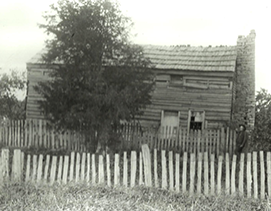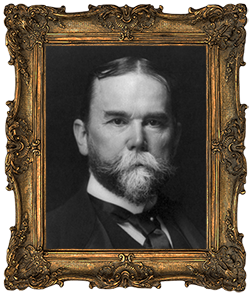Washington County's Pioneer Forts
By Jeremy L. Elliott
In the early years of the settlement of our county, tensions ran high between the American pioneers and the American Indians all across the Northwest Territory. These tensions would occasionally erupt into acts of aggression against one another, some of this violence occurred in the boundaries of Washington County and a substantial amount of incidents occurred alarmingly nearby.
After more than a decade of relative peace, Territorial Governor William Henry Harrison insulted and agitated the Indians of our state by attempting to acquire more land, from the White River, north into central Indiana, in 1809. The Miami Confederacy of Indians did not want to relinquish their rights to these lands due to the abundance of wildlife in the White River Valley, which had been essential for both, hunting and their fur trade for centuries. One of the key figures in the confederacy was the great Shawnee War Chief, Tecumseh, who despite not having the full endorsement of all the rest of the tribes, concluded that the only way to stop the onslaught of American settlers, was to wage a great war and push them back across the Ohio River. He had begun to gather likeminded tribes around Prophetstown, in Tippecanoe County.
McKnight Fort pictured AboveA wave of paranoia began to slowly build through the pioneer settlements of southern Indiana, in fear, that the Indians would return to the war path and sweep down from the north to wreak death and destruction upon them. Governor Harrison ordered the militia to begin constructing numerous block house forts across the northern edges of these settlements, to offer a place of refuge to the pioneers in case of an Indian attack. Additionally, several of the more affluent families began erecting over-sized houses of large, heavy, planed poplar logs, complete with port holes for fighting Indians from. It was built and furnished to serve as a protective fort, big enough to accommodate several families from the surrounding neighborhood, during times of Indian hostilities.
Several of these fort/houses were built in Washington County from the years of 1809 to 1812. McKnight Fort in Washington County IndianaIn the fall of 1811, Governor Harrison elected to launch a preemptive strike against Tecumseh's warrior forces gathered at Prophetstown, in an attempt to reduce the impending threat against the southern Indiana pioneer settlements. Several of our county's earliest residents were veterans of the ensuing Battle of Tippecanoe, where the Indiana Militia narrowly escaped from being completely routed, save for a final charge from the Harrison County Yellow Jackets, which at the time, included the men from the future Washington County, that repulsed the Indian forces from the battlefield.
McKnight Fort in Washington County IndianaIn the fall of 1811, Governor Harrison elected to launch a preemptive strike against Tecumseh's warrior forces gathered at Prophetstown, in an attempt to reduce the impending threat against the southern Indiana pioneer settlements. Several of our county's earliest residents were veterans of the ensuing Battle of Tippecanoe, where the Indiana Militia narrowly escaped from being completely routed, save for a final charge from the Harrison County Yellow Jackets, which at the time, included the men from the future Washington County, that repulsed the Indian forces from the battlefield.
Harrison, his surviving troops and most pioneers believed this victory would quell any further Indian raids, however, in hindsight this action seemed to only further enrage many of the tribes and by the following year the attacks had increased significantly, leading up to the War of 1812.
From the spring of 1812, until the autumn of 1813, all of the resolute pioneer residents across the area, who were not members of the militia, spent the bulk of their time living in these local forts for protection. Washington County settlers took shelter in the forts, when the last bands of resident Delaware Indians left the county in April, just months before the outbreak of war. The morning of their departure, they stole numerous horses from residents across the northern townships, kidnapped two young boys from the Royse's Lick settlement and brutally killed Battle of Tippecanoe veterans, Daniel and Jacob Soliday, before escaping and riding north to join the tribes with Chief Tecumseh.
The fear and hysteria reached a fever pitch by September, with the Pigeon Roost Massacre in neighboring Scott County, where the little settlement was decimated by Shawnee and Delaware warriors. Preceding this attack, many of Southern Indiana's settlers fled back across the Ohio River into Kentucky, but the more determined continued to shelter in the local forts.
After a relatively quiet winter, our residents were reminded of the dangerous realities of the war, when three men, two of which were Battle of Tippecanoe veterans, were killed near Fort Vallonia in the spring of 1813. Following these murders, what is believed to be the last Indian attack in Washington County occurred at the lonely cabin of John Huffman, in Gibson Township, where he was killed and his wife, who was severely wounded, managed to escape and eventually recovered.
Prior to the beginning of the war, William Henry Harrison resigned his appointment of territorial governor and resumed command of the militia. Through the summer months of 1813, General Harrison's army had forced nearly all of the hostile Indians into Canada and the high levels of tension endured by the pioneers of Southern Indiana began to relax significantly.
All of the pioneer citizens were thrilled to leave the confines of the forts and return to their own homesteads, where they would resume their efforts to improve their land and ultimately continue the progress towards bringing civilization to the county. By the end of the war, in 1815, the old local forts simply became large homes and these terrifying, anxiety riddled times of Washington County's earliest residents, became history.
Although it is suspected there were several more, the known local pioneer forts were
- Beck's Fort, where there were reported to be two forts near the mill and one was believed to be one of the largest in the county.
- Brewer's Fort, was located in the present day Salem city limits, on the west banks of Brock's Creek and was owned by Benjamin Brewer.
- Brock's Fort, was owned by George Brock and was just north of Salem, near Brock's Creek.
- The Callaway Fort, was the home of the famed Indian fighter, Micajah Callaway.
- Colonel Dawalt's Fort, was located on land presently between Chapel Hill Rd. and Day Rd.
- Fort Dublin, also known as, the Thompson Fort, was located in Franklin Township, is recorded as the largest in our area, housing 10 to 15 families during hostilities and garnered its name from the amount of Irish descendants who sheltered there.
- Fleenor's Fort, north of Salem, near Kossuth, owned by John Fleenor, who despite pioneer statistics, lived to be 105 years old and fathered 25 children. This fort became very popular for the early militia's Muster Days.
- The Fort at Fort Hill, was located in close proximity to today's Fort Hill Church.
- The Hattabaugh Fort, was an actual fort, with a row of cabins built together and the grounds were fenced in with high blockhouses constructed on the ends. It was located north of Salem, near Plattsburg and was owned by George Hattabaugh.
- The Hensley Fort, thought to be situated near the Washington and Franklin Township borders.
- Lick Fort, at Royse's Lick, owned by Frederick Royse.
- The Little Fort, on the north side of present day Canton, owned by Judge Alexander Little.
- Logan's Fort, located near Kossuth and owned by Colonel Ezekiel Logan.
- The McKnight Fort, sat on Section 8, in Franklin Township and was owned by William McKnight.
- Parr's Fort, owned by Captain Enoch Parr and was located in Franklin Township.
- The Quaker Fort, was situated between the present day locations of the Blue River Hicksite Church and the Blue River Friends Orthodox Church and was owned by Samuel and Mary Lindley.
- Rodman's Fort, was another in Franklin Township, between Canton and New Philadelphia.
- Sinking Springs Fort, a large fort was constructed near the present day site of the Sinking Springs Church.
- Young's Fort, was owned by James Young and was in close proximity to Brock's Fort, just north of Salem.


